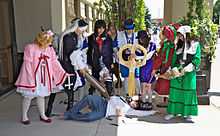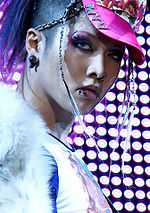Japanese pop culture in the United States
The flow of Japanese animation and manga to the United States has increased American awareness of Japanese animation. Anime differs from American animation in the range of its audiences and themes. Anime and manga incorporate a multitude of genres such as romance, action, horror, comedy, drama and cover a wide variety of topics like teen suicides, high school rivalries, and social rebellion. Described as a gateway for many fans that takes them to a whole new culture; it is used as a way to learn about Japan. People who are avid devotees to anime in the United States affectionately refer to themselves as otaku, although in Japan the term is similar to geek. Much like punk and goth, anime has become a subculture.
Anime in the United States
The effect of anime in the United States can been seen in different forms.
Anime conventions
Primarily the function of anime conventions in the United States is to give a place to fans of anime, manga and Japanese culture. There are a range of informational panels offered at these conventions from the basics of Japanese language and culture to cutting edge news about anime releases in Japan and the US. Anime conventions also provide performances and vendors of Japanese goods, manga, anime, figurines and Anime related merchandise. Most American anime conventions are fan operated, the increase in popularity starting in the '90s, sprung forth a long standing list of annual conventions, such as Anime Expo, AnimeFest, Otakon, and Anime Boston, which continue to today with numbers of attendance reaching over 10,000.
Anime influence and sales
Through the last two decades the introduction of anime into American main stream culture has furthered its popularity. Such famous titles as Sailor Moon, Dragon Ball Z, and most importantly Pokémon have influenced anime's appeal to young Americans.[1] "Anime already makes up an estimated 60% of all broadcast animation across the world." "ICv2 estimates the size of the North American anime market at $275-300 million" (in retail dollars)."[2] To compete with its Japanese competitors, many production companies in the US have adjusted their style to one inspired by anime to hold onto their viewers. An important example that has sparked much controversy in the animation world would be Avatar: The Last Airbender. A popular show on Nickelodeon, the characters have a distinct anime style, even the expressions and mannerism drawn evoke that of anime style. Teen Titans on Cartoon Network is yet another example of anime's influence on cartoons, as well as a popular comic strip turned cartoon called The Boondocks.
American cosplayers

The term "cosplay" corresponds to an abbreviation of the English words costume play, though the term was coined in Japan the practice is not solely Japanese. The use of the term cosplay applies to any costumed role play out side of theaters. Characters are often taken from popular Japanese fiction. Popular sources that fans draw from include anime, manga, video games, comic books, and graphic novels. American cosplayers practice this form of fandom at anime conventions. However, there are a growing number of web pages and photo sites dedicated to the art of cosplaying, such as DeviantArt and Cosplay.com.
Manga influences and sales
Calvin Reid of Publishers Weekly estimated that the "Total U.S. manga sales in 2007 rose about 10%, to more than $220 million, and about 1,468 titles are estimated to have been released last year."[3] With the popularity of manga on the rise graphic novel artists are beginning to adapt their style to that of manga. Manga provides diversity in the graphic novel department not seen in the American comic book industry. In a different trend celebrities are getting their hands into the manga market, rock star Courtney Love has published her own manga called Princess Ai. The production of original English language manga has started. CBR columnists Joe Casey and Matt Fraction describe the increase of manga sales in the United States, "Manga is the 900-pound bear in the comics shop. Inescapable, unavoidable, and impossible to ignore, the manga explosion is either going to go away—which is bad, as so many mass-market bookstores seem to be bulking up their comics supply based on manga's lead—or manga will continue to grow—also bad, as the direct market scrambles to keep up. The entire industry is being forced, month by month, little by little, into a paradigm shift not seen since the advent of the direct market in the early '80s, all thanks to these strange little books from far away."[4]
Music

Japanese pop and rock music acts are also increasing in popularity amongst US listeners. Such artists include L'Arc-en-Ciel, Miyavi, T.M.Revolution, Hikaru Utada, Asian Kung-Fu Generation, Dir En Grey, Yellow Magic Orchestra, and Susumu Hirasawa. Growing in popularity by the year these performers have toured the United States at least twice playing at small venues in Boston, New York City and Los Angeles each time increasing their fan base. Japanese American artist Hikaru Utada released an English debut album in 2004, her single "Devil Inside" topped the Billboard Hot Dance/Club Airplay charts. Dir En Grey, in early 2006 started touring the US. Japanese idols, like Morning Musume, AKB48 and S/mileage are now becoming known in the US thanks to the internet. In 2009, Morning Musume performed at Anime Expo and in 2010 AKB48 played there. Also in 2010, influential metal band X Japan performed their first US tour, selling out most shows. In April 2011, Berryz Kobo played at an anime convention in Washington.
See also
Notes
- ↑ http://publications.epress.monash.edu/doi/pdf/10.2104/cc100012
- ↑ "Anime DVDs Down 20%". February 13, 2008. Retrieved December 10, 2010.
- ↑ Reid, Calvin (December 7, 2007). "New Report Finds Manga Sales Up; Anime DVD Down in '07". Retrieved December 10, 2010.
- ↑ Comic Book Resource (September 28, 2004). "The Basement Tapes Issue #9". Retrieved December 10, 2010.
References
Baus, J. (2007-12-17). "Anime Releases TumbleManga Market Girds for Challenges".
Kelts, Roland (2006). Japanamerica: How Japanese Pop Culture Has Invaded the U.S. New York: Palgrave Macmillan.
Sarafin, J. (2008-04-24). "Manga Sales Rose Slightly in America".
Schodt, Frederik L. (2007). Dreamland Japan: Writings on Modern Manga. Berkeley, CA: Stone Bridge Pr.
Sefton-Green, Julian (2003). Digital Diversions: Youth Culture in the Age of Multimedia. London: Stone Bridge Pr.
Vocaloids